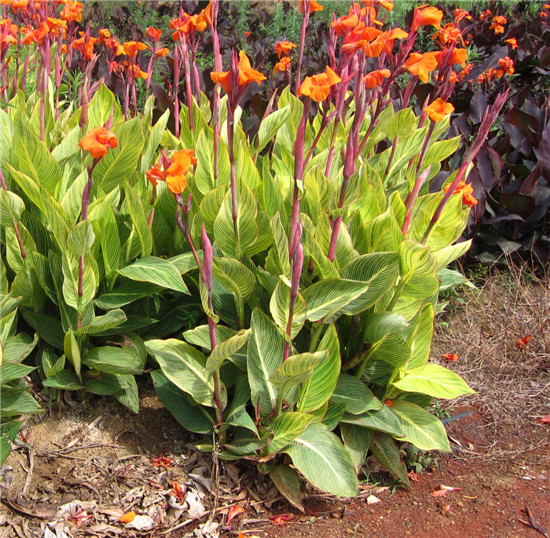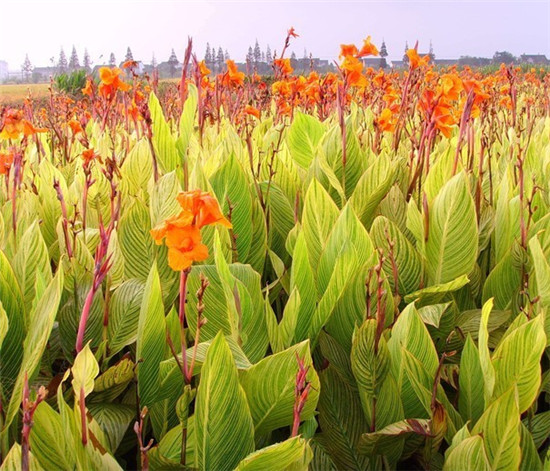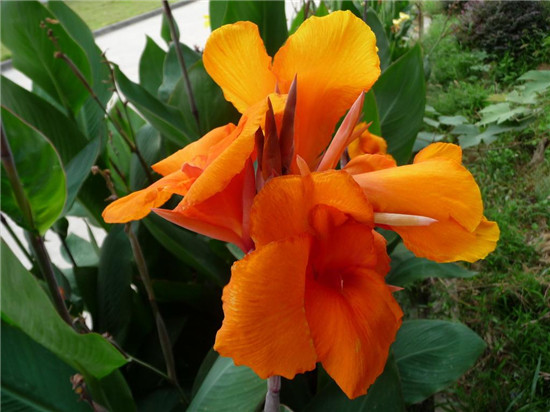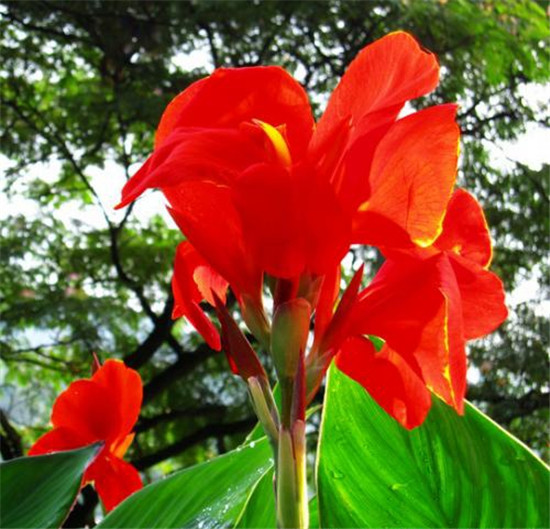Planting methods of flower-leaf canna planting techniques of flower-leaf canna
Flower-leaf canna belongs to the genus Canna of Canna family, which is one of the most common canna varieties, which is very suitable for indoor pot culture. Next, let's take a look at the planting method of flower-leaf canna.

Flower-leaf canna is a horticultural variety of canna. Perennial perennial herb. Dwarf, plant 50-80cm high, with stout rhizomes, leaves broadly oval, alternate, with obvious midrib and pinnate lateral veins, inlaid with soil yellow, cream yellow, green and yellow colors. Terminal raceme with about 10 flowers, red, slightly smaller than terrestrial canna. The flowering period is from July to October, and the annual green period is about 240 days.
Flower-leaf canna is one of the newly introduced canna varieties in recent years. Like canna, it has strong growth, few diseases and insects, and a long flowering period. what is more, its plant is low, only about 50 meters high, and it is very suitable for potted plants. moreover, its parallel veins are golden, and on the new leaves that roll and feel comfortable, if the make-up cuisine sleeves are embedded with gold thread, they are delicate and lovely.
What is Canna plantain?
Flower-leaf canna is a horticultural variety of canna which is a perennial perennial herb. It belongs to the genus Canna of the Banana family. Short, with stout rhizomes, leaves wide oval, alternate, with obvious midrib and pinnate lateral veins, inlaid with soil yellow, cream yellow, green and yellow colors. Perennial perennial herb.

The function of Canna sativa L.
1. Ornamental value: flowers and leaves Canna red glowing, bright leaves. It is suitable for group planting in wetlands and flower diameter, or in ponds in small clumps. In addition to embellishment, it can also purify air and water quality. Flower and leaf canna with or without flowers can be watched, whether placed in a single pot or group scenery, can form a pleasant bright spot.
two。 Medicinal value: the rhizomes and flowers of flower canna can be used as medicine, they can clear heat and dampness, calm nerves and reduce blood pressure, and flower canna is of great significance in purifying air. it can absorb not only the main components of automobile exhaust such as sulfur dioxide and hydrogen chloride, but also carbon dioxide, so it is not difficult to understand why flower canna can be seen in many urban green belts.
Morphological characteristics of Canna sativa L.
Is a perennial evergreen tufted herb. The plant is 70-150 cm tall; the rhizome is fleshy. Leaves alternate, long oval-lanceolate, 20-30 cm long and 10-13 m wide. Leathery, golden leaves intermingled with fine green stripes, margin red, entire. Raceme, terminal, with 2-3 branches, flowers orange-red. Florescence: may-November.

Propagation and cultivation of Canna sativa L.
It is suitable to choose dwarf varieties for potted canna. Generally, the proportion of rotten leaf soil, vegetable garden soil and rice chaff ash is 1.5-0.5, and a small amount of bean cake, bone meal and other fertilizers are added.
From March to April in spring, take out the tuber, remove the rotten part, select the stem with 2-3 strong teeth and bury it in the basin soil, preferably with the bud tip exposed. Because canna is very fond of fertilizer and resistance to moisture, the basin should be watered thoroughly. When the fifth leaf grows, mature topdressing is applied every 7-10 days, and then watered after fertilization. Generally, 1% ferrous sulfate fertilizer and water is applied once a month, or a small amount of plant ash is added to make the stem straight and strong, the leaves green and thick, and the flowers bright. Stop fertilizing at the flowering stage. If you put it in a cooler place during flowering, you can prolong the flowering period. When the flower at the end of the stem lags behind, the stem branch should be cut off from the base at any time in order to sprout new buds and grow flower branches to blossom one after another.

Potted canna sometimes has scorched and yellowed leaves, mainly due to excessive application of ferrous sulfate or drought and hot sun exposure. In the hot summer, if poured too cold water will also cause the leaf edge scorch, such as in the heat of summer fertilization is too thick, there will be cauterization of the rhizome to "burn". In addition, when the temperature is above 40, the canna can be moved to a cool and ventilated place. Before and after Frosts Descent, the potted canna can be moved to a temperature of 5-10 to survive the winter safely, and fertilization should be stopped during the overwintering period.
The above is the whole content of the introduction of the planting methods and techniques of flower-leaf canna for you. I hope this article can help you. Please continue to follow us.
Related
- Wuhan Hospital Iron Tree Blooming Result Was Instantly Frightened by the Gardener Master
- Which variety of camellia is the most fragrant and best? Which one do you like best?
- What is the small blue coat, the breeding methods and matters needing attention of the succulent plant
- Dormancy time and maintenance management of succulent plants during dormancy
- Minas succulent how to raise, Minas succulent plant pictures
- What are the varieties of winter succulent plants
- How to raise succulent plants in twelve rolls? let's take a look at some experience of breeding twelve rolls.
- Attention should be paid to water control for succulent plants during dormant period (winter and summer)
- Watering experience of twelve rolls of succulent plants
- Techniques for fertilizing succulent plants. An article will let you know how to fertilize succulent plants.



